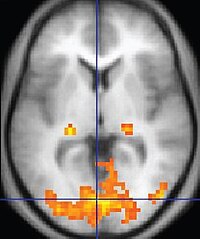
Photo from wikipedia
ABSTRACT Recent technological advances have allowed the development of portable functional Near‐Infrared Spectroscopy (fNIRS) devices that can be used to perform neuroimaging in the real‐world. However, as real‐world experiments are… Click to show full abstract
ABSTRACT Recent technological advances have allowed the development of portable functional Near‐Infrared Spectroscopy (fNIRS) devices that can be used to perform neuroimaging in the real‐world. However, as real‐world experiments are designed to mimic everyday life situations, the identification of event onsets can be extremely challenging and time‐consuming. Here, we present a novel analysis method based on the general linear model (GLM) least square fit analysis for the Automatic IDentification of functional Events (or AIDE) directly from real‐world fNIRS neuroimaging data. In order to investigate the accuracy and feasibility of this method, as a proof‐of‐principle we applied the algorithm to (i) synthetic fNIRS data simulating both block‐, event‐related and mixed‐design experiments and (ii) experimental fNIRS data recorded during a conventional lab‐based task (involving maths). AIDE was able to recover functional events from simulated fNIRS data with an accuracy of 89%, 97% and 91% for the simulated block‐, event‐related and mixed‐design experiments respectively. For the lab‐based experiment, AIDE recovered more than the 66.7% of the functional events from the fNIRS experimental measured data. To illustrate the strength of this method, we then applied AIDE to fNIRS data recorded by a wearable system on one participant during a complex real‐world prospective memory experiment conducted outside the lab. As part of the experiment, there were four and six events (actions where participants had to interact with a target) for the two different conditions respectively (condition 1: social‐interact with a person; condition 2: non‐social‐interact with an object). AIDE managed to recover 3/4 events and 3/6 events for conditions 1 and 2 respectively. The identified functional events were then corresponded to behavioural data from the video recordings of the movements and actions of the participant. Our results suggest that “brain‐first” rather than “behaviour‐first” analysis is possible and that the present method can provide a novel solution to analyse real‐world fNIRS data, filling the gap between real‐life testing and functional neuroimaging. HIGHLIGHTSA novel GLM‐based method to recover the timing of functional events from fNIRS data.The method showed high specificity and sensitivity in synthetic and real data.The method is applied to fNIRS data conducted outdoor on a freely moving participant.
Journal Title: Neuroimage
Year Published: 2017
Link to full text (if available)
Share on Social Media: Sign Up to like & get
recommendations!